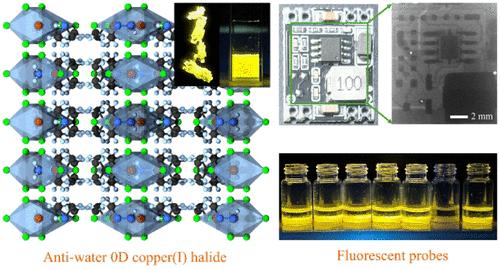Water-Resistant Zero-Dimensional Hybrid Copper Halide for High-Efficiency X-ray Scintillation and Sensitive Fluorescent Probing
IF 4.7
2区 化学
Q1 CHEMISTRY, INORGANIC & NUCLEAR
引用次数: 0
Abstract
Low-dimensional hybrid metal halides, known for their highly tunable structures and exceptional photophysical properties, have attracted considerable interest for luminescent, optoelectronic, and sensing applications. In this study, we report on the synthesis and characterization of [ACPP]2Cu4Br8 (ACPP = protonated 1-amino-4-cyclopentylpiperazine), a lead-free zero-dimensional organic–inorganic copper(I) halide with outstanding scintillation performance. The material achieves a high photoluminescence quantum yield (92.4%), an exceptional X-ray scintillation light yield (43,000 ± 300 photons MeV–1), a low X-ray detection limit (0.139 μGyair s–1), and high-resolution X-ray imaging capability, making it a promising candidate for advanced X-ray imaging technologies. Furthermore, its crystals exhibit excellent emission stability in water and reversible fluorescence quenching with high sensitivity and selectivity toward nitrobenzene, which is an organic pollutant. These findings highlight the potential of this ecofriendly luminescent material for next-generation optical and sensing technologies.

用于高效x射线闪烁和灵敏荧光探测的防水零维杂化卤化铜
低维杂化金属卤化物以其高度可调的结构和卓越的光物理特性而闻名,在发光、光电和传感应用中引起了相当大的兴趣。在这项研究中,我们报道了[ACPP]2Cu4Br8 (ACPP =质子化1-氨基-4-环戊基哌嗪)的合成和表征,这是一种具有优异闪烁性能的无铅零维有机-无机卤化铜(I)。该材料具有高光致发光量子产率(92.4%)、优异的x射线闪烁光产率(43,000±300个光子MeV-1)、低x射线检测限(0.139 μGyair s-1)和高分辨率x射线成像能力,使其成为先进x射线成像技术的有希望的候选者。此外,其晶体在水中具有优异的发射稳定性和对有机污染物硝基苯具有高灵敏度和选择性的可逆荧光猝灭。这些发现突出了这种环保发光材料在下一代光学和传感技术中的潜力。
本文章由计算机程序翻译,如有差异,请以英文原文为准。
求助全文
约1分钟内获得全文
求助全文
来源期刊

Inorganic Chemistry
化学-无机化学与核化学
CiteScore
7.60
自引率
13.00%
发文量
1960
审稿时长
1.9 months
期刊介绍:
Inorganic Chemistry publishes fundamental studies in all phases of inorganic chemistry. Coverage includes experimental and theoretical reports on quantitative studies of structure and thermodynamics, kinetics, mechanisms of inorganic reactions, bioinorganic chemistry, and relevant aspects of organometallic chemistry, solid-state phenomena, and chemical bonding theory. Emphasis is placed on the synthesis, structure, thermodynamics, reactivity, spectroscopy, and bonding properties of significant new and known compounds.
 求助内容:
求助内容: 应助结果提醒方式:
应助结果提醒方式:


